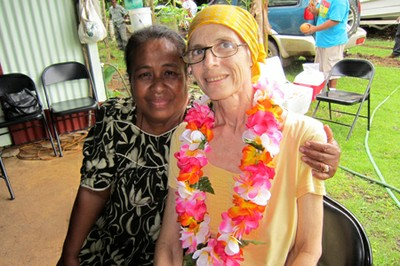
I don’t know whether Lois Englberger actually saw the interview that has just been published in Farming Matters, the renamed LEISA magazine. In a way, it doesn’t matter. The result is both a very personal history of Lois’ involvement with the Island Food Community of Pohnpei and a useful and informative guide not only to what works and what doesn’t but also to the kind of thinking needed. Here’s a tiny extract:
What didn’t work?
Because the FSM is traditionally an oral society we found that written documents, like newsletters, worked for some groups – leaders especially – but not for the community. Furthermore, we found that people were reticent when simply advised to plant more local foods. Cooking classes and recipes thus proved to be a very effective means of motivating people, and inspiring them to want to grow local food. In general, however, perceptions are very difficult to change. Although community members were told on a number of occasions that their unhealthy lifestyles were to blame for their failing health it seemed like the message didn’t really sink in. People close their ears to messages, so we learnt that repetition is important.
You can read the whole thing here and download the entire special issue on Regional Food Systems. And a special tip of the hat to our friends Jess Fanzo and Danny Hunter, who helped compile the special issue, and Teresa Borelli, who wrote up the interview with Lois.
But how do we define `local’? Is it only traditional crops, or perhaps indigenous crops? Is eating cassava leaves in Africa traditional or local – certainly not indigenous? Is eating tomato anywhere wrong? Where did the `local’ bananas in the FSM originally come from?
First we had the pre-Columbian system, where people had to eat truly local crops, and had to have – short of disease problems – a nutritious `local’ diet (maize-beans-squash and the like). Then we had more than 400 years of crop introduction – everything everywhere it would grow, Vavilov, Fairchild, Captain Bligh (this is the one I like). Then we – the plant genetic resource community – started to care about indigenous crops and varieties. But these crops and varieties may be less nutritious (or even less `locally adapted’ if they go down with local pests and diseases) than crops from the other side of the globe.
I am fairly certain the `Columbian exchange’ gave better diet and food choice in most regions than anything our genetic resource movement has done in the last 50 years. And while imported rice and wheat for bread may damage health, I am certain that importing fruit and vegetables as commodities to Northern Europe has given me a lot more nutritious diet than all the salting, bottling, preserving fruit and vegetables of 100 years ago (when only the very rich had ice-houses and orangeries).
Perhaps the slogan should be `home grown’ rather than `local’ or `traditional’: I doubt if farmers in S. America and Africa know that 70% of the crops they grow are introduced (and therefore not local or traditional?).